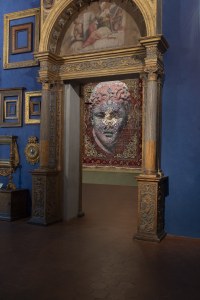In his latest works - showcased earlier this year at the Stefano Bardini Museum in Florence as part of the exhibition "Senza Data" (Undated) - Pignatelli attempted a sort of journey through time and space.
He came up with a series of prints on railway tarpaulin, wood, paper and metal sheets, but also recreated paintings of classical statues on Persian carpets.
These images from classical times are summoned from the past, like ghosts trying to dialogue with the other works on display in the museum, from Tino da Camaino's 14th century "Charity" to Donatello's Madonna of the Apple and Madonna of the Ropemakers, Bernardo Daddi's Crucifixion, Antonio del Pollaiolo's St. Michael Archangel and "Atlas" by Giovanni Francesco Barbieri.
Pignatelli's carpets are the most interesting pieces of his latest production: apart from going well with the museum carpet collection and with the colours of the walls in the museum trademark "Bardini blue" (a shade the art dealer and collector brought back from one of his trips to Russia and that later on became the symbol of the museum), these new pieces allow the artist to look at the concept of time via sculptures, paintings and textiles, and create a sort of stratification of techniques, times and cultures (it is worth noting that, in some cases, the artist incorporated his stratified textiles into the tapestry of chairs or integrated them inside a wooden cabinet).
The historical time of the creation of the statues replicated on the carpets and the time of the creation of the carpets overlap to provide visitors with new collective memories. In a way Pignatelli's "undated" carpets are to be interpreted as mobile and nomadic artworks: they can be taken off the wall, rolled and easily transported somewhere else.
Excerpt: Irenebrination: Notes on Architecture, Art, Fashion, Fashion Law & Technology



